The Analysis of Pneumatic Wheel Rim Deformation While Hitting an Obstacle
Abstract
:1. Introduction
2. Materials and Methods
3. Model Subject to Numerical Research
- C10 = 0.14 MPa;
- C01 = 1.8 MPa;
- D1 = 0 MPa;
- ρ = 1100 kg/m3.
- Spring stiffness 22,000 N/m;
- Shock absorber damping coefficient (dashpot coefficient) 2000 Ns/m.
4. Modeling Results
4.1. Hitting a Symmetrical Obstacle
4.2. Hitting an Asymmetrical Obstacle
5. Research on a Real Object
6. Conclusions
Author Contributions
Funding
Institutional Review Board Statement
Informed Consent Statement
Data Availability Statement
Conflicts of Interest
References
- Pokorski, J.; Reński, A.; Sar, H. System for investigation of friction properties of the road surface. Balt. J. Road Bridge Eng. 2015, 10, 126–131. [Google Scholar] [CrossRef]
- Skrúcaný, T.; Vrábel, J.; Kendra, M.; Kažimír, P. Impact of cargo distribution on the vehicle flatback on braking distance in road freight transport. MATEC Web Conf. 2017, 134, 00054. [Google Scholar] [CrossRef]
- Vrabel, J.; Stopka, O.; Rievaj, V.; Šarkan, B.; Pruskova, K.; Michalk, P. Measuring the resistance of tires for passenger vehicle against the rolling and sliding on loading area of the flatbed truck when providing the transport services. Commun. Sci. Lett. Univ. Zilina 2016, 18, 124–128. [Google Scholar] [CrossRef]
- Wang, Y.; Hu, J.; Wang, F.; Dong, H.; Yan, Y.; Ren, Y.; Zhou, C.; Yin, G. Tire Road Friction Coefficient Estimation: Review and Research Perspectives. Chin. J. Mech. Eng. 2022, 35, 6. [Google Scholar] [CrossRef]
- Stan Bezpieczeństwa ruchu Drogowego oraz Działania Realizowane w tym Zakresie w 2020 r. Uchwała nr 1/2021, Krajowej Rady Bezpieczeństwa Ruchu Drogowego z dnia 22 Kwietnia 2021 r. (In Polish). Available online: https://www.krbrd.gov.pl/wp-content/uploads/2021/05/Stan-bezpieczenstwa-ruchu-drogowego-oraz-dzialania-realizowane-w-tym-zakresie-w-2020-r.pdf (accessed on 10 March 2022).
- Kalasova, A.; Čulík, K.; Hajnik, A. Young Drivers and Their Risky Behavior on the Roads. In Proceedings of the 2020 12th International Science-Technical Conference Automotive Safety, Automotive Safety 2020, Kielce, Poland, 21–23 October 2020; p. 9293520. [Google Scholar]
- Pajković, V.; Grdinić-Rakonjac, M. Age-related differences in attitudes and perception on road safety issues in Montenegro. Transp. Res. Proc. 2022, 60, 584–591. [Google Scholar] [CrossRef]
- Szumska, E.; Frej, D.; Grabski, P. Analysis of the causes of vehicle accidents in Poland in 2009–2019. LOGI Sci. J. Transp. Logist. 2020, 11, 76–87. [Google Scholar] [CrossRef]
- Linkov, V.; Perůtka, J.; Zaoral, A.; Tučka, P.; Ťápal, A.; Zůvala, R.; Řezáč, P. The speed behavior of Czech professional drivers according to ordinary vs. variable speed limit signs: An on-road and driving simulation based comparison. Perner’s Contacts 2019, 14, 35–43. [Google Scholar]
- Ágoston, G.; Madlenák, R. Road safety macro assessment model: Case study for Hungary. Period. Polytech. Transp. Eng. 2021, 49, 89–92. [Google Scholar] [CrossRef] [Green Version]
- Czech, P. Underage pedestrian road users in terms of road accidents. Adv. Intell. Syst. Comput. 2017, 505, 33–44. [Google Scholar]
- Gogola, M.; Ondrus, J. Road safety perspective of small children. In Proceedings of the 12th International Science-Technical Conference Automotive Safety, Automotive Safety 2020, Kielce, Poland, 21–23 October 2020; p. 9293525. [Google Scholar]
- Hájnik, A.; Harantová, V.; Kalašová, A.; Čulík, K. Traffic modeling of intersections on Vajnorská street in Bratislava. Transp. Probl. 2021, 16, 29–40. [Google Scholar] [CrossRef]
- Mamcarz, P.; Droździel, P.; Madleňáková, L.; Sieradzki, A.; Droździel, P. Level of occupational stress, personality and traffic incidents: Comparative study of public and freight transport drivers. Transp. Res. Proc. 2019, 40, 1453–1458. [Google Scholar] [CrossRef]
- Pecyna, A.; Krzysiak, Z.; Zarajczyk, J.; Buczaj, A.; Kobus, Z.; Pieniak, D. Safety during transport of hazardous materials in Poland. Przem. Chem. 2019, 98, 1517–1521. [Google Scholar]
- Wang, Z.; Suga, S.; Nacpil, E.J.C.; Yang, B.; Nakano, K. Effect of Fixed and sEMG-Based Adaptive Shared Steering Control on Distracted Driver Behavior. Sensors 2021, 21, 7691. [Google Scholar] [CrossRef] [PubMed]
- Borawski, A.; Szpica, D.; Mieczkowski, G.; Borawska, E.; Awad, M.M.; Shalaby, R.M.; Sallah, M. Theoretical analysis of the motorcycle front brake heating process during high initial speed emergency braking. J. Appl. Comput. Mech. 2020, 6, 1431–1437. [Google Scholar]
- Erd, A.; Jaśkiewicz, M.; Koralewski, G.; Rutkowski, D.; Stoklosa, J. Experimental research of effectiveness of brakes in passenger cars under selected conditions. In Proceedings of the 11th International Science and Technical Conference Automotive Safety, Automotive Safety 2018, Žastá, Slovakia, 18–20 April 2018; pp. 1–5. [Google Scholar]
- Ondruš, J.; Vrábel, J.; Kolla, E. The influence of the vehicle weight on the selected vehicle braking characteristics. In Proceedings of the International Conference 2018, Transport Means, Trakai, Lithuania, 3–5 October 2018; pp. 384–390. [Google Scholar]
- Šarkan, B.; Jaśkiewicz, M.; Kiktová, M. The impact of the truck loads on the braking efficiency assessment. Open Eng. 2020, 10, 105–112. [Google Scholar] [CrossRef]
- Jaśkiewicz, M.; Lisiecki, J.; Lisiecki, S.; Pokropinski, E.; Wieckowski, D. Facility for performance testing of power transmission units. Sci. J. Marit. Univ. Szczec. 2015, 42, 14–25. [Google Scholar]
- Szpica, D. Modeling of the operation of a pneumatic differential valve increasing the efficiency of pneumatic brake actuation of road trains. In Proceedings of the International Conference 2018, Transport Means, Trakai, Lithuania, 3–5 October 2018; pp. 151–156. [Google Scholar]
- Dižo, J.; Blatnický, M.; Sága, M.; Harušinec, J.; Gerlici, J.; Legutko, S. Development of a New System for Attaching the Wheels of the Front Axle in the Cross-Country Vehicle. Symmetry 2020, 12, 1156. [Google Scholar] [CrossRef]
- Gorbunov, M.; Dižo, J.; Blatnický, M.; Kravchenko, K.; Semenov, S.; Mikhailov, E. Proposal of a method for detection of a damaged hydraulic shock absorber in a vehicle’s suspension system. Commun. Sci. Lett. Univ. Zilina 2022, 24, B41–B48. [Google Scholar] [CrossRef]
- Jurecki, R.; Jaśkiewicz, M.; Wdowski, T. Testing the influence of car load and pressure in tyres on the value of damping of shock absorbers specified with the use of the Eusama method. Diagnostyka 2014, 15, 45–50. [Google Scholar]
- Vaiciunas, G.; Steišunas, S.; Dižo, J. The nadal criterion study in a passenger car with independently rotating wheels. In Proceedings of the International Conference 2020, Transport Means, Kaunas, Lithuania, 30 September–2 October 2020; pp. 878–883. [Google Scholar]
- Lukac, M.; Brumercik, F.; Krzywonos, L. Driveability simulation of vehicle with variant tire properties. Commun. Sci. Lett. Univ. Zilina 2016, 18, 34–37. [Google Scholar] [CrossRef]
- Orynycz, O.; Tucki, K.; Wasiak, A.; Sobótka, R.; Gola, A. Evaluation of the brake’s performance dependence upon technical condition of car tires as a factor of road safety management. Energies 2019, 13, 9. [Google Scholar] [CrossRef] [Green Version]
- Rievaj, V.; Vrabel, J.; Hudak, J. Tire inflation pressure influence on a vehicle stopping distances. Int. J. Traffic Transp. Eng. 2013, 2, 9–13. [Google Scholar]
- Trnka, L.; Gogola, M. Analysis of the tire contact area pressure on the road. Perner’s Contacts 2019, 14, 49–59. [Google Scholar]
- Kubba, A.E.; Jiang, K. A Comprehensive study on technologies of tyre monitoring systems and possible energy solutions. Sensors 2014, 14, 10306–10345. [Google Scholar] [CrossRef]
- Szczucka-Lasota, B.; Węgrzyn, T.; Łazarz, B.; Kamińska, J.A. Tire pressure remote monitoring system reducing the rubber waste. Transp. Res. D Trans. Environ. 2021, 98, 102987. [Google Scholar] [CrossRef]
- Bukova, B.; Tengler, J.; Brumercikova, E. A Model of the Environmental Burden of RFID Technology in the Slovak Republic. Sustainability 2021, 13, 3684. [Google Scholar] [CrossRef]
- Droździel, P.; Krzywonos, L.; Madlenak, R.; Rybicka, I. Selected aspects of analyses of failure rates of active safety systems in buses. Komunikacie 2014, 16, 114–119. [Google Scholar] [CrossRef]
- Gnap, J.; Jagelčák, J.; Marienka, P.; Frančák, M.; Kostrzewski, M. Application of mems sensors for evaluation of the dynamics for cargo securing on road vehicles. Sensors 2021, 21, 2881. [Google Scholar] [CrossRef]
- Wang, H.; Sun, Y.; Gao, Z.; Chen, L. Extension coordinated multi-objective adaptive cruise control integrated with direct yaw moment control. Actuators 2021, 10, 295. [Google Scholar] [CrossRef]
- Previati, G.; Ballo, F.; Gobbi, M.; Mastinu, G. Radial impact test of aluminum wheels—Numerical simulation and experimental validation. Int. J. Impact Eng. 2019, 126, 117–134. [Google Scholar] [CrossRef]
- Chauhan, M.; Kotwal, G.; Majge, A. Numerical Simulation of Tire and Wheel Assembly Impact Test Using Finite Element Method. SAE Tech. Paper 2015. [Google Scholar] [CrossRef]
- Kocabicak, U.; Firat, M. Numerical analysis of wheel cornering fatigue tests. Eng. Fail. Anal. 2001, 8, 339–354. [Google Scholar] [CrossRef]
- Firat, M.; Kozan, R.; Ozsoy, M.; Mete, O.H. Numerical modeling and simulation of wheel radial fatigue tests. Eng. Fail. Anal. 2009, 16, 1533–1541. [Google Scholar] [CrossRef]
- Santiciolli, F.M.; Moller, R.; Krause, I.; Dedini, F.G. Simulation of the scenario of the biaxial wheel fatigue test. Adv. Eng. Softw. 2017, 114, 337–347. [Google Scholar] [CrossRef]
- SAE J175, SAE Standards; Wheels—Lateral Impact Test Procedures—Road Vehicles. SAE International: Warrendale, PA, USA, 2016.
- ISO 7141, ISO Standards; Road Vehicles—Light Alloy Wheels—Impact Test. ISO: Geneva, Switzerland, 2005.
- Rader—Anforderungen und Prufungen, Arbeitskreis Lastenheft, Arbeitskreis-Lastenheft AK-LH 08, Arbeitskreis der Firmen: Audi AG, Bayerische Motorenwerke AG, Daimler Chrysler AG, Porsche AG, Volkswagen AG, 2006.
- Ballo, F.; Previati, G.; Mastinu, G.; Comolli, F. Impact tests of wheels of road vehicles: A comprehensive method for numerical simulation. Int. J. Impact Eng. 2020, 146, 103719. [Google Scholar] [CrossRef]
- Neves, R.R.V.; Micheli, G.B.; Alves, M. An experimental and numerical investigation on tyre impact. Int. J. Impact Eng. 2010, 37, 685–693. [Google Scholar] [CrossRef]
- Chang, C.L.; Yang, S.H. Simulation of wheel impact test using finite element method. Eng. Fail. Anal. 2009, 16, 1711–1719. [Google Scholar] [CrossRef]
- Yuan, X.M.; Zhang, L.J.; Chen, X.Y.; Du, B.; Li, B.H.; Fan, L.G.; Pan, Y. Numerical Simulation of Aluminum Alloy Wheel 13° Impact Test Based on Abaqus. Appl. Mech. Mater. 2012, 215–216, 1191–1196. [Google Scholar] [CrossRef]
- Sokolov, S.L. Calculation of the stress-strain state of pneumatic tires by the finite element method. J. Mach. Manuf. Reliab. 2007, 36, 45–49. [Google Scholar] [CrossRef]
- An Integrated Approach for Transient Rolling of Tyres. Abaqus Technology Brief 2007. Available online: https://imechanica.org/files/Automotive-SIMULIA-Tech-Brief-03-Integrated-Approach-Transient-Tires-Full.pdf (accessed on 2 March 2022).
- Wang, Z.; Li, B.; Liang, C.; Wang, X.; Li, J. Response Analysis of a Scraper Conveyor under Chain Faults Based on MBD-DEM-FEM. Stroj. Vestn. J. Mech. Eng. 2021, 67, 501–515. [Google Scholar] [CrossRef]
- Sojka, M.; Čornák, Š.; Droppa, P. Selected problems of tracked vehicle movement modelling. In Proceedings of the 21st International Scientific Conference Transport Means 2017, Juodkrante, Klaipėda, Lithuania, 20–22 September 2017; pp. 493–498, Code 135093. [Google Scholar]
- Wan, X.; Liu, X.; Shan, Y.; Jiang, E.; Yuan, H. Numerical and experimental investigation on the effect of tire on the 13° impact test of automotive wheel. Adv. Eng. Softw. 2019, 133, 20–27. [Google Scholar] [CrossRef]
- ISO 4000-2:2013; Passenger Car Tyres and Rims—Part 2: Rims. ISO: Geneva, Switzerland, 2013.
- Gao, Q.; Shan, Y.; Wan, X.; Feng, Q.; Liu, X. 90-degree impact bench test and simulation analysis of automotive steel wheel. Eng. Fail. Anal. 2019, 105, 143–155. [Google Scholar] [CrossRef]

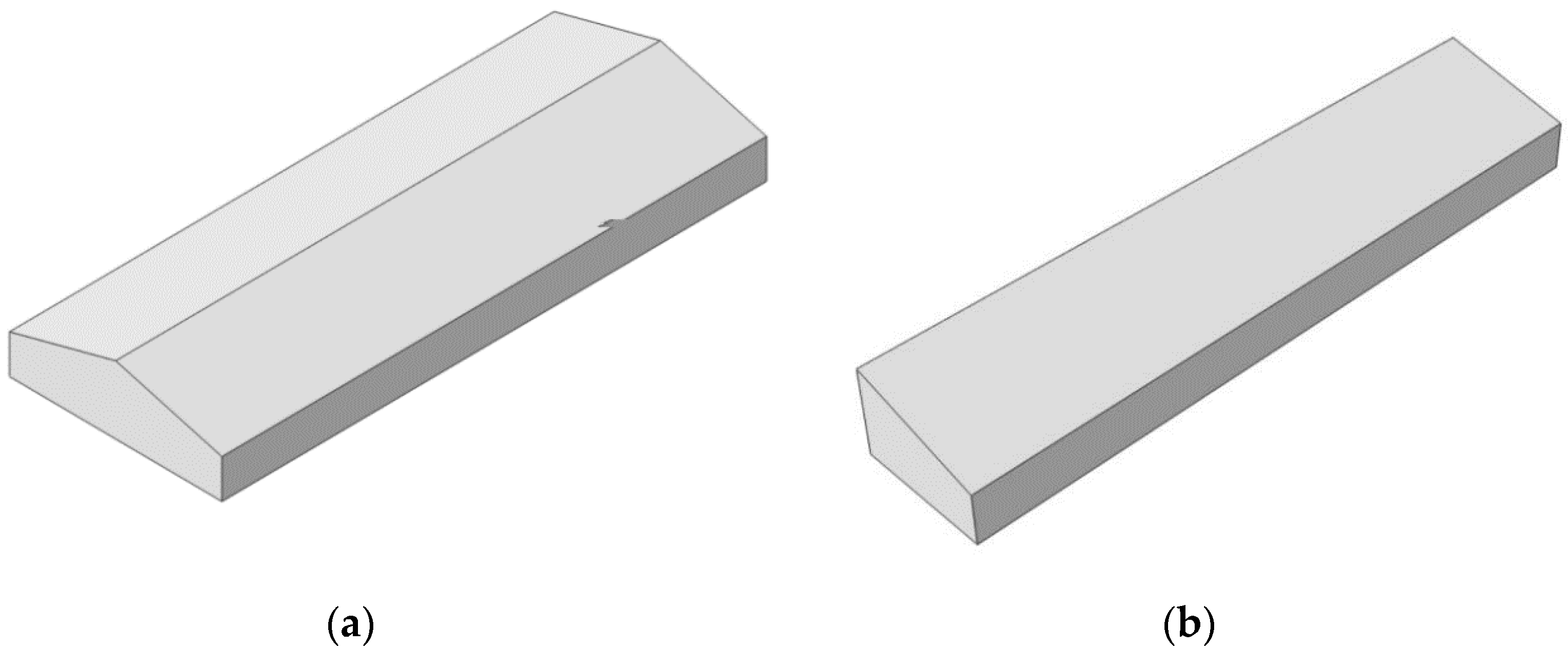
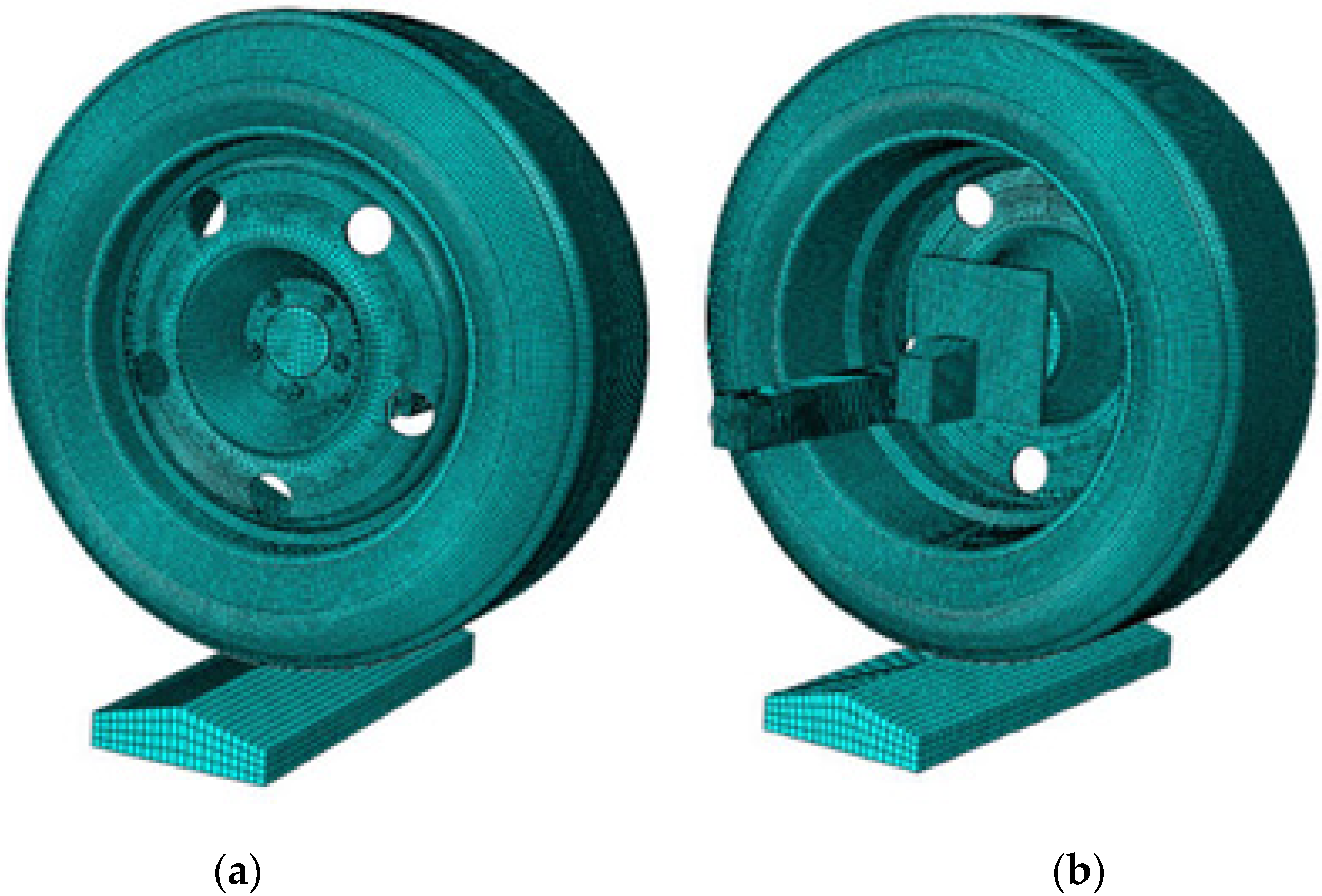
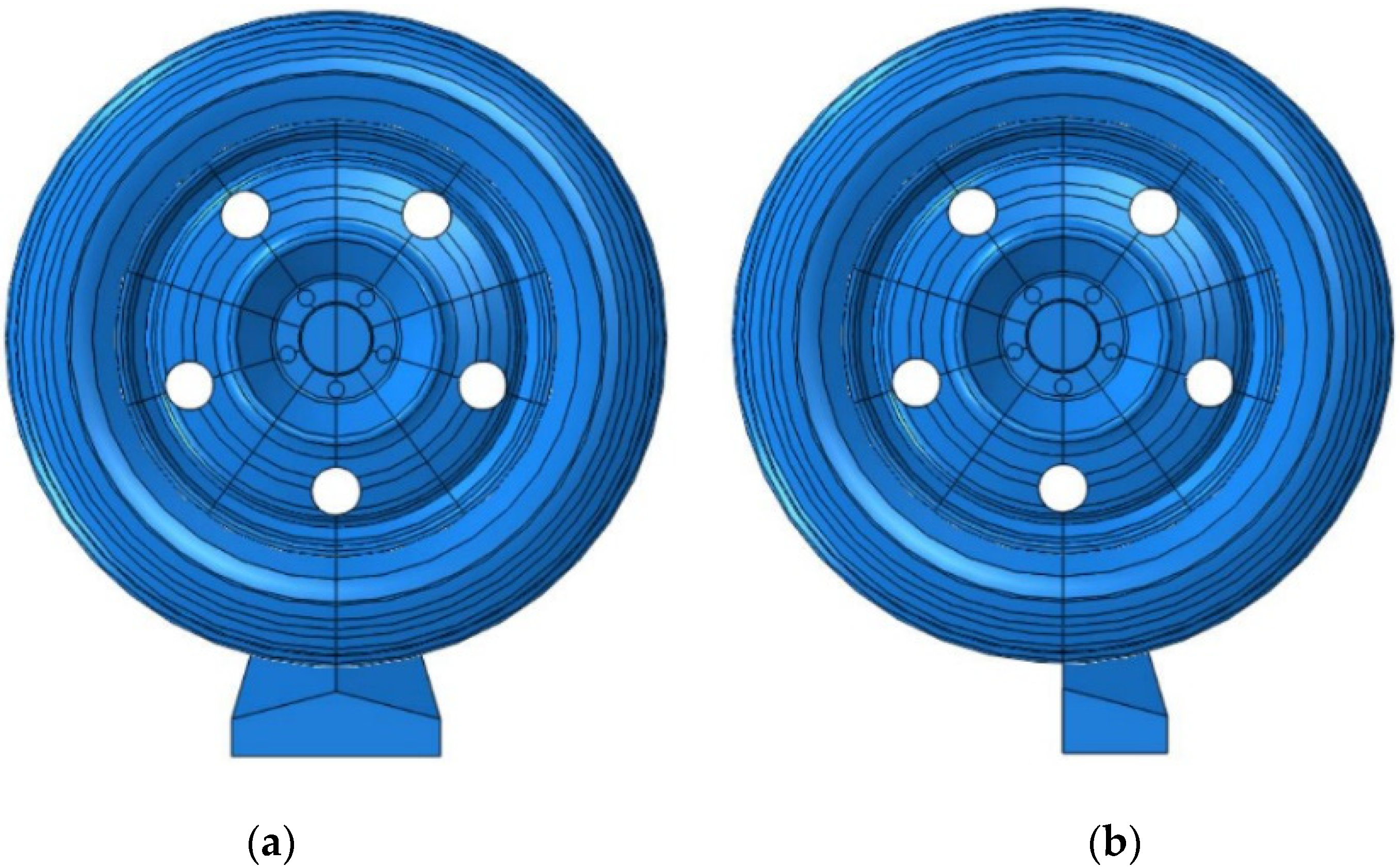
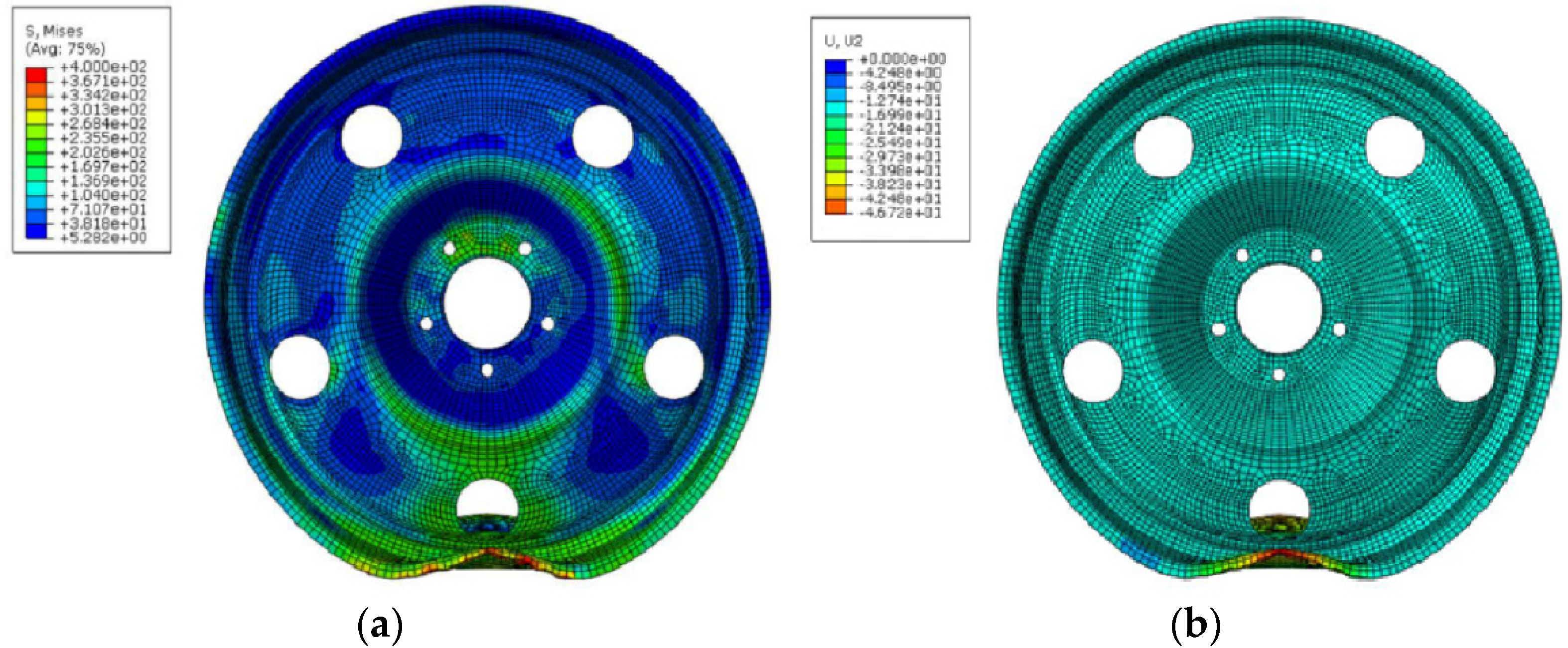


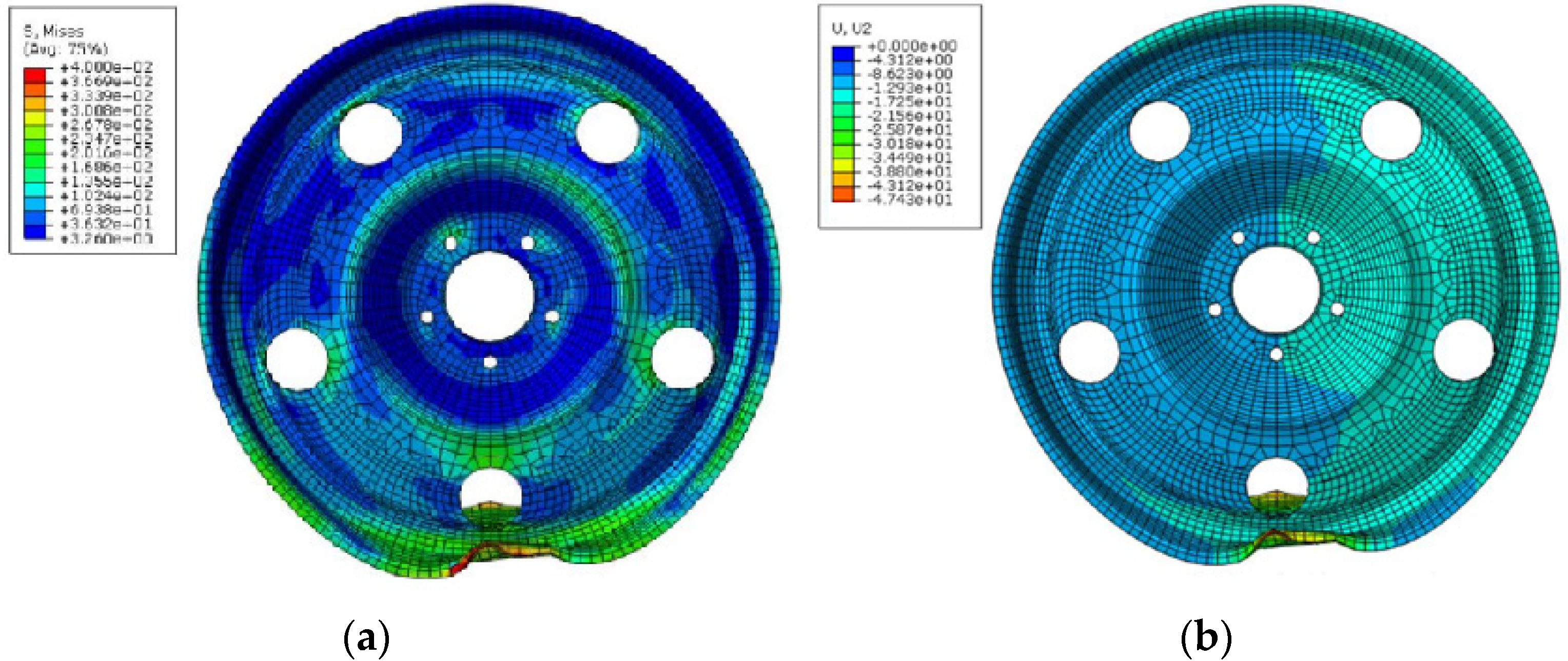
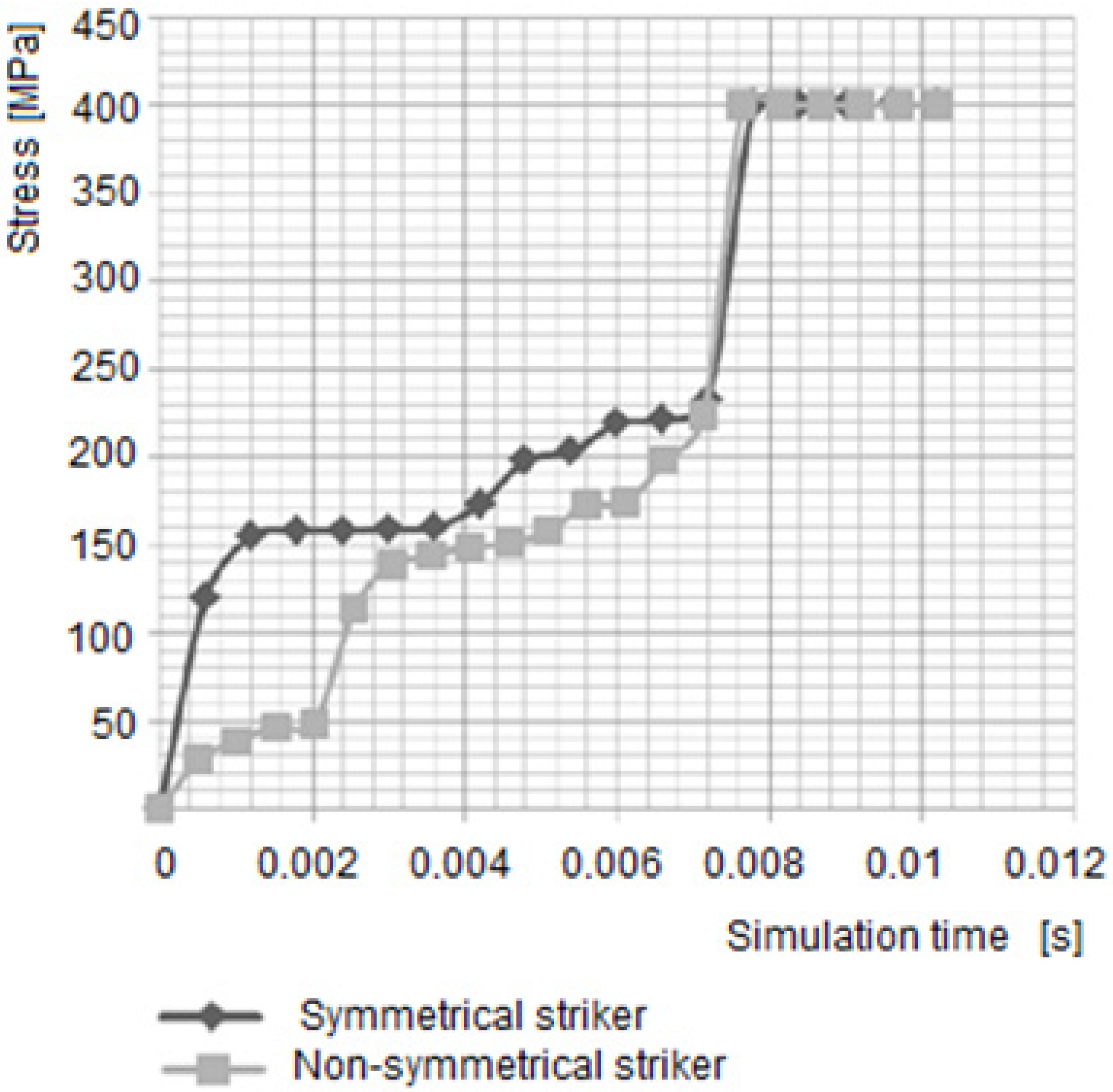
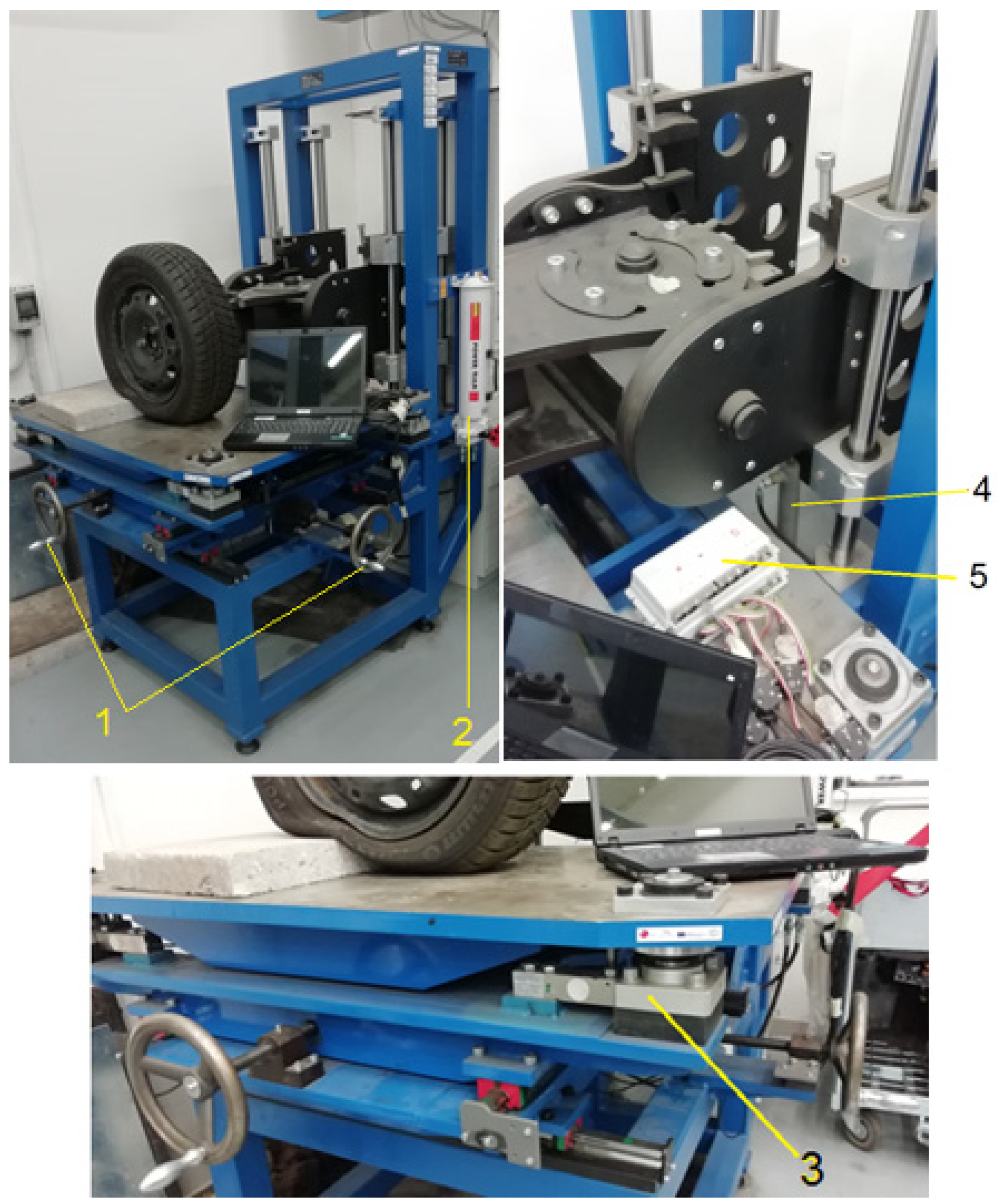

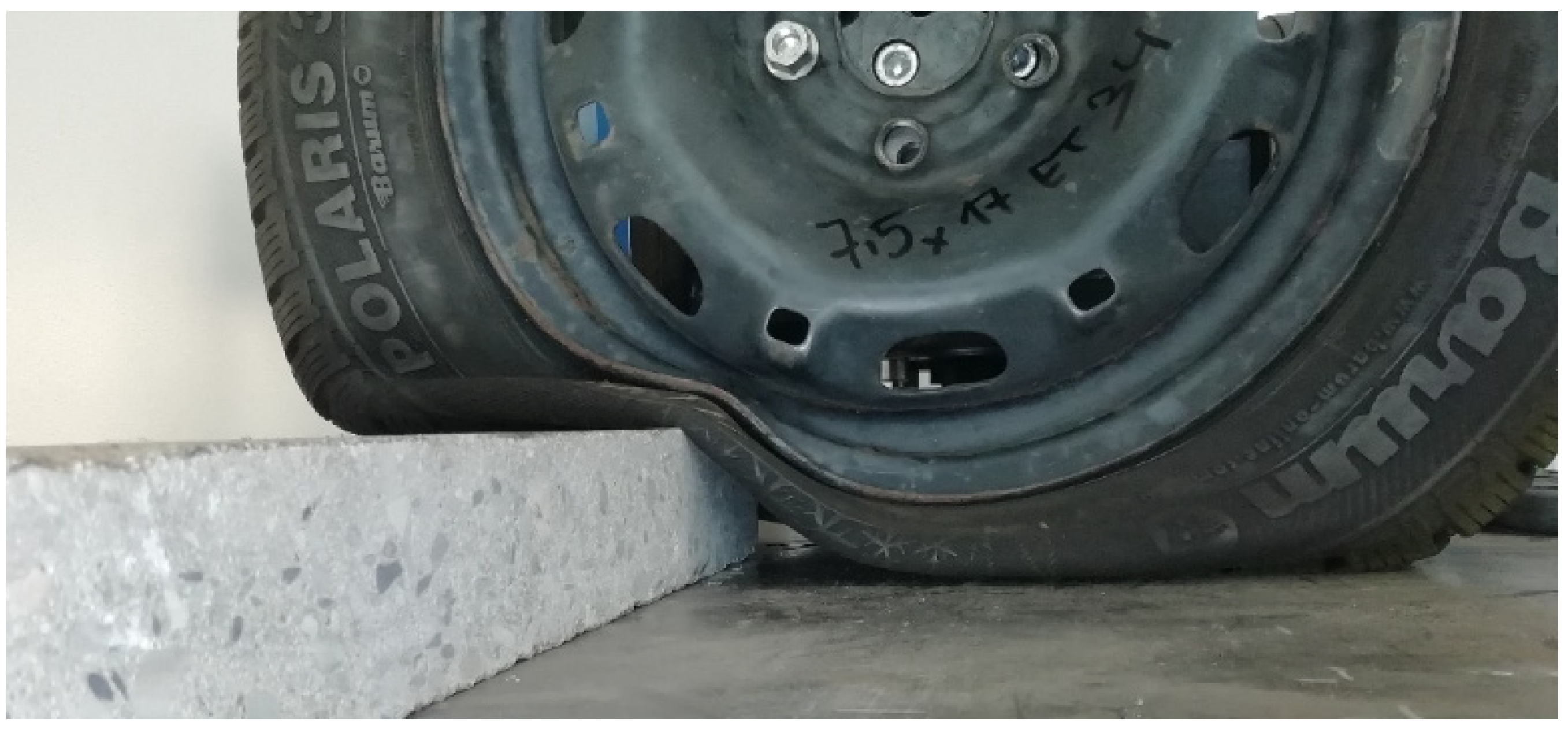
| Model | Type of Finite Elements | Number of Finite Elements | Number of Nodes |
|---|---|---|---|
| Tire | C3D8R | 78,719 | 109,783 |
| Rim | C3D8R | 34,656 | 53,228 |
| Wheel hub | C3D8R | 1703 | 2384 |
| The steel belt inside the tire | S4R | 2540 | 2667 |
| Obstacle | R3D4 | 2560 | 2562 |
Publisher’s Note: MDPI stays neutral with regard to jurisdictional claims in published maps and institutional affiliations. |
© 2022 by the authors. Licensee MDPI, Basel, Switzerland. This article is an open access article distributed under the terms and conditions of the Creative Commons Attribution (CC BY) license (https://creativecommons.org/licenses/by/4.0/).
Share and Cite
Tarkowski, S.; Nieoczym, A.; Caban, J.; Jilek, P.; Sejkorová, M. The Analysis of Pneumatic Wheel Rim Deformation While Hitting an Obstacle. Appl. Sci. 2022, 12, 6371. https://doi.org/10.3390/app12136371
Tarkowski S, Nieoczym A, Caban J, Jilek P, Sejkorová M. The Analysis of Pneumatic Wheel Rim Deformation While Hitting an Obstacle. Applied Sciences. 2022; 12(13):6371. https://doi.org/10.3390/app12136371
Chicago/Turabian StyleTarkowski, Sławomir, Aleksander Nieoczym, Jacek Caban, Petr Jilek, and Marie Sejkorová. 2022. "The Analysis of Pneumatic Wheel Rim Deformation While Hitting an Obstacle" Applied Sciences 12, no. 13: 6371. https://doi.org/10.3390/app12136371
APA StyleTarkowski, S., Nieoczym, A., Caban, J., Jilek, P., & Sejkorová, M. (2022). The Analysis of Pneumatic Wheel Rim Deformation While Hitting an Obstacle. Applied Sciences, 12(13), 6371. https://doi.org/10.3390/app12136371







